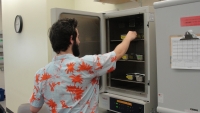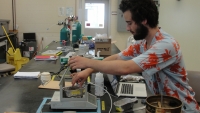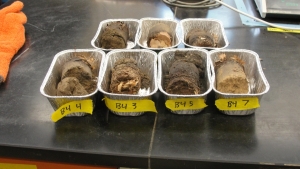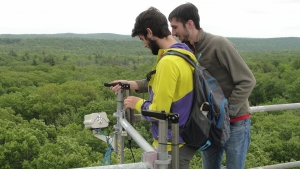You are here
Seeing Forrest through the Trees
I've heard a lot of puns, jokes, and quips since starting my research internship at the Harvard Forest last month. But I guess when your parents name you after a bohemian misspelling of a New England biome, you get what you deserve.
So whether it was destiny, free will, or "Popular Baby Names 1995" that brought me here, I've come to love my time at the Harvard Forest.
To rewind a bit, the Harvard Forest (spelled with only one 'r') is actually what it sounds like—a forest, owned by Harvard University, with trees, plants, moose, and everything else characteristic of the Massachusetts wilderness. The 3,700-acre outdoor research laboratory in Petersham, MA, was originally founded in 1907 to serve as Harvard's school of forestry, but has since evolved into its own department within the Faculty of Arts and Sciences. I, along with 20 other college-aged "scientists" from universities around the country, am here for 11 weeks as part of the Harvard Forest Summer Research Program in Ecology, an REU (Research Experience for Undergraduates) program funded by the National Science Foundation (aka your tax dollars—thanks mom!). We all live, eat, and work together—some of us on individual research projects and others in groups—alongside research mentors that guide us through designing and executing a unique project, and finally presenting our work at a final Research Symposium in August. Our lodging is a luscious 18th century cabin in the woods (read: mansion) with catered food provided by chef extraordinaire Tim, whose brownie pudding makes it ever-harder to get out the door in the morning for field work.
I, along with 20 other college-aged "scientists" from universities around the country, am here for 11 weeks as part of the Harvard Forest Summer Research Program in Ecology, an REU (Research Experience for Undergraduates) program funded by the National Science Foundation (aka your tax dollars—thanks mom!). We all live, eat, and work together—some of us on individual research projects and others in groups—alongside research mentors that guide us through designing and executing a unique project, and finally presenting our work at a final Research Symposium in August. Our lodging is a luscious 18th century cabin in the woods (read: mansion) with catered food provided by chef extraordinaire Tim, whose brownie pudding makes it ever-harder to get out the door in the morning for field work.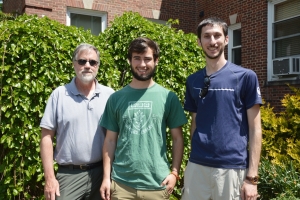 Everyone here, including the full-time research scientists, focuses on a unique micro niche of ecology ranging from analyzing ant foraging distances to examining hurricane disturbance forest dynamics. Together with my research mentor Evan Goldman and under the supervision of Senior Research Fellow J. William Munger of the Wofsy-Munger Group, my project aims to document the interannual variability of the carbon content in soil organic matter.
Everyone here, including the full-time research scientists, focuses on a unique micro niche of ecology ranging from analyzing ant foraging distances to examining hurricane disturbance forest dynamics. Together with my research mentor Evan Goldman and under the supervision of Senior Research Fellow J. William Munger of the Wofsy-Munger Group, my project aims to document the interannual variability of the carbon content in soil organic matter.
My workspace is split between a soil laboratory located in Torrey Building on Harvard Forest's main campus and the 375-hectare Prospect Hill forest tract about a mile hike from Torrey. There, my work focuses on 34, 10-meter-radius circular biometric plots lying along ten 500-meter transects that stem from a central tower.
To test for soil organic carbon, my day-to-day involves a combination of field and lab work with time allocations often determined by the weather forecast and what Tim is cooking for lunch. In the field, I partition my time sweating, swatting mosquitoes, getting lost, pulling off ticks, and worrying about Lyme disease. When not doing one of the aforementioned activities, I also extract soil cores from the ground, identify leaf litter species, separate organic layers of soil from mineral layers, and carry the dirt carefully back to the lab, where I dry, sieve, and weigh the cores and then incinerate 3-gram homogenous samples in a 550-degree C muffle furnace. Through this process, all organic material is isolated and then burned off, allowing us to ascertain the percent of each core that is organic material and, thus, contains carbon.
Last summer, Harvard Forest REU student Marisa Houlahan extracted and processed 136 soil cores from 20-meter transects tangent to the 34 biometric plots, creating a baseline for the magnitude of organic material contained in the Prospect Hill tract of the Harvard Forest. By taking soil cores this summer directly parallel to the 2014 samples and using the same methods in the lab, I'm able (theoretically) to document interannual variability in the carbon stock. The emphasis on "theoretically" stems from that if I'm not too careful in my methods, my results just might show interannual variability of scientists' biases, which peer-reviewed journals aren't as fond of.
After my samples have been located, extracted, and analyzed in the lab, I plan on spending the last third of my summer doing data analysis processing using RStudio to measure changes between the 2014 and 2015 samples. The results will be compared to eddy flux data taken from the Environmental Measurement Station (EMS) tower that has recorded net ecosystem exchange of carbon dioxide from June 2014 to June 2015.
My project will (hopefully) present the first detailed quantitative assessment of interannual variability measurements in soil organic matter estimates for the Harvard Forest. I expect the net flux of carbon content from 2014 to 2015 to parallel the net flux of carbon into the biosphere at Harvard Forest as measured by the EMS tower. Though it'll be another 7 weeks of research until I can conclude for certain, I'll make sure not to dwell too much on the details until then so I can keep seeing the Forrest for the trees!
This summer, Forrest's blog posts will also be featured by the Harvard Office for Sustainability.

